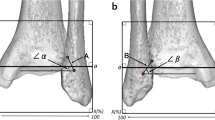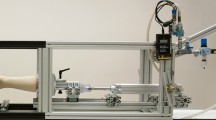Summary
The proximal tibiofibular joint (TFJ) was studied in 489 dry bones and 50 specimens of dissected knees. A marked variability in morphological characteristics was found with frequent osteoarthritic changes. The most common types of joint found were the trochoid and the double trochoid, followed by the plane type. No articular facet could be recognised in 10 dry fibulae and 12 dry tibiae. The inclination of the joint ranged between 5° and 80°. Osteoarthritis of some degree was present in the TFJ joint in 83 fibulae (27%) and 80 tibiae (38%). It was associated with osteoarthritis of the knee joint, especially affecting the medial compartment, in 30% of cases. Osteoarthritis of the TFJ was also found in a case of multiple exostoses and in a specimen with Bejel disease. No correlation could be established between the presence of the ‘squating facets’ in the distal end of the tibia and the morphological characteristics or pathology of the TFJ.
A clinical case of osteoarthritis of the TFJ in a women of 57 is presented, and the differential diagnosis of pain over the lateral aspect of the knee is discussed.
Résumé
L'articulation péronéo-tibiale supérieure (A.P.T.S.) a été étudiée sur 489 os secs et 50 dissections de genou. On a mis en évidence une grande variété des caractéristiques morphologiques ainsi que de fréquentes modifications arthrosiques. Les types les plus habituels sont la trochoïde et la double trochoïde, suivis par l'arthrodie. Il n'y avait pas de facette articulaire sur 10 péronés et 12 tibias secs. L'inclinaison articulaire variait de 5° à 80°. Une arthrose de l'A.P.T.S., plus ou moins importante était présente sur 83 péronés (27%) et 80 tibias (38%). Elle était associée dans 30% des cas à une arthrose du genou, atteignant plus particulièrement le compartiment interne. Une arthrose de l'A.P.T.S. a également été trouvée dans un cas d'exostoses multiples et dans une maladie de Béjel. Il n'a pas pu être établi de corrélation entre la présence de «squating facets» à l'extrémité inférieure du tibia et les caractéristiques morphologiques ou pathologiques de l'A.P.T.S.
Présentation d'une observation clinique d'arthrose péronéo-tibiale supérieure chez une femme de 57 ans et discussion du diagnostic différentiel des douleurs de la face externe du genou.
Similar content being viewed by others
References
Arensburg, B.: Squatting facets of the tibia. Personal communication
Barnett, C. H., Napier, J. R.: The axis of rotation of the ankle joint in man. Its influence upon the form of the talus and mobility of the fibula. J. Anat. 86, 1–9 (1952)
Basmajian, J. V.: Primary anatomy, 6th ed. pp. 111–112, Baltimore: The Williams and Wilkins Co. 1970
Brash, J. C.: Cunningham's manual of practical anatomy, 12th ed., Vol. 1. London: Oxford University Press 1958
Davies, D. V.: Gray's anatomy, 34th ed. London: Longman 1967
Hudson, E. H.: Non-venereal syphilis: a sociological and medical study of Bejel. Edinburgh and London: E. and S. Livingstone Ltd. 1958
Lambert, K. L.: The weight-bearing function of the fibula. J. Bone Joint Surg. [Am.] 53, 507–513 (1971)
Ogden, J. A.: The anatomy and function of the proximal tibiofibular joint. Clin. Orthop. 101, 186–191 (1974)
Ogden, J. A.: Subluxation of the proximal tibiofibular joint. Clin. Orthop. 101, 192–197 (1974)
Preuschoft, H.: Die mechanische Beanspruchung der Fibula bei Primaten. Gegenbaurs Morph. Jahrb. 117, 211–216 (1971)
Satinoff, I.: Study of the squatting facets of the talus and tibia in ancient Egyptians. J. Human Evol. 1, 209–212 (1972)
Singh, I.: Squatting facets on the talus and tibia in Indians. J. Anat. 93, 540–550 (1959)
Tobias, P. V., Arnold, M.: Man's anatomy. III. Johannesburg: Witwatersrand University Press 1967
Weeks, C.: Occasional communications between the synovial sacs of knee and proximal tibiofibular joints. Am. J. Surg. 4, 798–800 (1930)
Author information
Authors and Affiliations
Rights and permissions
About this article
Cite this article
Eichenblat, M., Nathan, H. The proximal tibio fibular joint. International Orthopaedics 7, 31–39 (1983). https://doi.org/10.1007/BF00267557
Issue Date:
DOI: https://doi.org/10.1007/BF00267557




